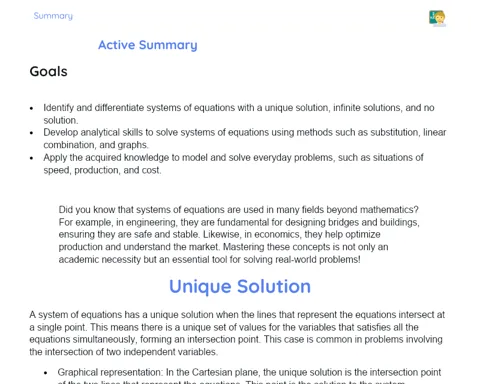INTRODUCTION TO VOLUME: RELATIONS WITH CUBES
The Relevance of the Topic
- Exploring Space: Understanding volume is fundamental to comprehend how three-dimensional objects occupy space.
- Building Concepts: Volume is a basic building block in mathematics, essential for many areas, including science and engineering.
- Practical Applications: Knowing how to calculate volume helps solve everyday problems, such as knowing the amount of liquid that fits in a box.
Contextualization
- From 2D to 3D: Students have already studied area in plane geometry; now, it's time to go beyond and explore the three dimensions.
- Cubes as a Basis: The cube, with all equal faces, is the key piece to understand and measure the volume of more complex figures.
- Interdisciplinarity: The concept of volume connects with other disciplines, such as sciences, when studying capacity and density.
Remember, explorers of the three-dimensional space! Every object around us, from the juice box to the school building, is an adventure through the world of volume that we are about to unravel! 🧱✨---
THEORETICAL DEVELOPMENT: DIVING INTO VOLUME USING CUBES
Components
-
Unit Cube: Small square block that serves as our basic unit of volume measurement.
- Relevance: Facilitates understanding and calculations of more complex volumes.
- Characteristics: Has all edges of the same size, usually 1 cm.
- How it contributes: With it, we imagine large structures being filled with these small blocks.
-
Volume: Space occupied by a three-dimensional object.
- Relevance: Fundamental to understand the capacity of containers and structures.
- Characteristics: Measured in cubic units, such as cm³, m³.
- How it contributes: Shows how much "stuff" fits inside another "thing".
-
Dimensions: Length, width, and height of an object.
- Relevance: Necessary to calculate the volume.
- Characteristics: Linear paths along the three directions of an object.
- How it contributes: Multiplying the three dimensions, we get the volume.
Key Terms
-
Cubic unit: Standard measure for volume in the form of a cube with 1 unit on each side.
- Origin: Concept comes from geometry, understanding shapes in three dimensions.
-
Multiplication: Mathematical operation that combines numbers by multiplying them.
- Development: Fundamental to calculate the volume, multiplying length, width, and height.
Examples and Cases
-
Ice cube in the mold: Imagine an ice cube that fits exactly inside a mold. Each face of the ice touches a face of the mold.
- Theory: If each side of the mold measures 1 cm, the volume of the ice cube is 1 cm³.
-
Toy box: A box is 5 cm high, 2 cm wide, and 10 cm long.
- Theory: The volume is 5 cm x 2 cm x 10 cm = 100 cm³. That is, 100 unit cubes of 1 cm³ would fit inside it.
-
Building with blocks: Build a rectangle with construction blocks, 3 blocks long, 2 wide, and 4 high.
- Theory: The volume is 3 (length) x 2 (width) x 4 (height) = 24 unit blocks.
Each concept here serves as a brick in the construction of our castle of knowledge about volume. Let's stack these blocks together and find out how many little cubes fit inside the magical figures of mathematics! 📦✨
DETAILED SUMMARY: VOLUME AND CUBES - A MATHEMATICAL ADVENTURE
Relevant Points
-
Understanding the Unit Cube:
- Cube of 1 cm on each edge, used as a base to measure volume.
- Simple to visualize and perfect for building the idea of volume.
-
Understanding Volume:
- Volume is the measure of the space that a three-dimensional object occupies.
- We calculate the volume by multiplying length, width, and height (volume = length × width × height).
-
Units of Measure:
- Volume is expressed in cubic units, such as cm³ or m³.
- Each cubic unit represents a little cube of 1 cm³.
-
Multiplication for Volume Calculation:
- The action of multiplying length, width, and height to find the total volume.
- Introduction to the idea that multiplying is adding equal groups.
-
Visualization and Construction:
- Use of physical blocks or drawings to visualize and construct three-dimensional shapes.
- Helps understand how volume is formed by the accumulation of layers.
Conclusions
-
Every Space Counts:
- Each little cube inside an object counts towards the total volume.
- Volume is more than size; it's the amount of space filled.
-
Mathematics in Real Life:
- Understanding volume helps assess space in everyday situations, like filling boxes or tanks.
-
CreSCER - Length, Width, and Height:
- Acronym to remember the steps of volume calculation: Length x Width x Height (CreSCER).
Exercises
-
Build the Volume:
- Use construction blocks to create a cube that is 3 cm long, 2 cm wide, and 2 cm high. How many blocks were used?
-
Volume of the Magic Box:
- Imagine a magic box with 4 cm long, 4 cm wide, and 4 cm high. What is the volume of the magic box in cm³?
-
Fill the Pool:
- A mini toy pool has a length of 5 cm, a width of 5 cm, and a depth of 2 cm. How many water cubes (1 cm³ each) are needed to completely fill the pool?
Let's use the power of numbers to unlock the hidden mysteries within the shapes around us! Hands on, little mathematicians! 🔍✨



